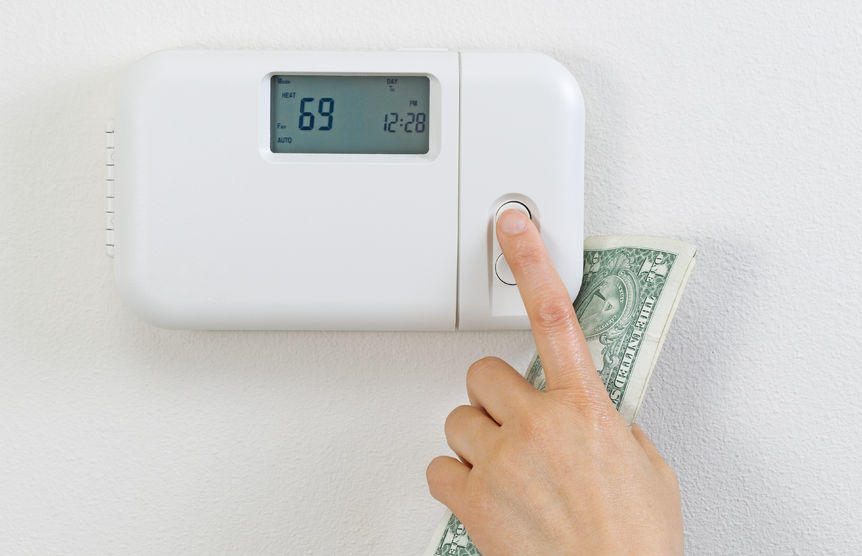For many, winter utility bills can be a pocketbook pain point. In fact, home heating is the largest energy expense in the average U.S. home and accounts for about 45% of energy costs. Fortunately, there are a lot of simple steps you can take today that will help reduce your utility costs immediately. We’ll also introduce you to a couple things you can do long term to significantly lower your winter bills.
10 Quick Ways You Can Reduce Your Home Winter Heating Gas Bill
There are a lot of simple measures you can take to reduce heat loss in your home. There are several areas in your home, for example, where drafts may be allowing warm air to escape. Take a look at our list below to see what things you can do to start saving money today.
- Close off vents and doors to rooms in your home that don’t need to be heated (i.e. if you have a guest bedroom that you only use when company comes to visit). Don’t pay to heat rooms you don’t use.
- Increasing the humidity in your home by 20%-40% can help your home feel warmer during the winter. You can use a humidifier, indoor plant or an aquarium to help increase humidity in your house.
- Regular maintenance of your furnace is important to maintain efficiency. Replacing your furnace filter once a month during the winter season will help your furnace work more efficiently. If you have a dirty filter or sensor, it forces your heater to work harder in order to heat your home. You can get a professional furnace tune-up annually to make sure your furnace is running well. Plus, regular inspections help keep your family safe because they perform a carbon monoxide test and will help you avoid unexpected heating failures.
- Preventing heat loss and reducing drafts in your home are some of the simplest ways that you can reduce your heating bill right away.
- Replace worn weather stripping on your windows and doors.
- Use weatherproof caulk to seal caulk and openings where warm air may be escaping.
- Adjust your door thresholds.
- Use an inflatable chimney balloon to keep warm air from escaping from your fireplace.
- Close your swamp cooler dampers before winter.
- Cover your windows with plastic film.
- Lock your doors and windows.
- Use the sun to help heat your home. Open the curtains during the day to let the sunshine warm your home. On the flip side, be sure to close your drapes at night to help retain the heat in your home.
- Run your ceiling fan clockwise (there’s a switch to reverse the blades’ rotation) to push the rising hot air back down. You can use the lowest fan speed so you won’t feel a “breeze.”
- Keep heater registers and radiators free from obstructions so the warm air can circulate. Also be careful that you don’t block vents in areas of your home where gas appliances are stored – this can be a serious safety hazard.
- Set your thermostat only to the temperature you’d like your house to reach. Turning your heat up to 75 degrees won’t heat your home any faster (it’s not like the gas pedal in your car). Also, programming your thermostat to match your schedule is a great way of controlling heating costs.
- Check to see if your air ducts are sealed and properly insulated, especially in the attic and crawl spaces. Look for places where the ducts may have pulled apart at the seams and corners. Energy Star says that a house with a forced-air furnace can lose up to 20% of the air that moves through the system to leaks, holes and poorly connected ducts! You can use mastic sealant or metal tape to cover and seal any leaks or you can call a professional to inspect or repair your ductwork.
- Using less hot water is a great way to use less energy and there are a few easy changes you can make to help reduce the amount of hot water you’re using.
- When you do laundry, wash your clothes in cold water as often as possible. You can also lower your water heater’s temperature setting to 120 degrees.
- If you have water lines in unheated parts of your home (like the garage), you can purchase polyethylene foam pipe insulation at your local home improvement store and install it on those exposed water lines.
- Installing low-flow shower heads are also a great way to conserve hot water.
- Turn the water heater thermostat down or off when you’re gone for more than three days. Newer water heaters typically have a “vacation” setting you can use, too. There is no reason to heat water if you’re not home.
4 Home Projects to Reduce Home Heating Costs
If you’re really looking to reduce your winter bills, there are a few other long-term things you can do that make a larger impact on your bill than some of the things we mentioned earlier.
Install an energy efficient heating & furnace system
A traditional single stage furnace operates in either “on” or “off” mode. A multi-stage furnace has a high and low speed. However, a variable speed motor allows the blower to adjust the speed of the motor incrementally based on the heating needs in your home. This type of motor increases fuel and electrical efficiency, provides consistent heat, reduces noise, and makes for cleaner air. Because the furnace adjusts the demand for heat, you’ll use less energy and electricity.
Properly Insulate Your home
Check insulation levels in your attic, exterior and basement walls, ceilings, floors and crawl spaces. Adding insulation is fairly easy and cost effective. You can tell if you have adequate insulation by measuring the thickness of your existing insulation. If it’s less than 11 inches of fiberglass, rock wool or 8 inches of cellulose (plant fiber insulation), then it’s helpful to add more insulation. Adding insulation to your crawl space or basement, however, can be a more complicated job and usually requires a contractor. A professional insulation expert will know how to properly install the insulation and is also trained to assess the area for any other issues that may need to be addressed. Did you know that the New Mexico Gas Company offers a rebate for 25% of the cost (up to $500) when you have a licensed and insured contractor add insulation to your home’s attic or roof?
Install a programmable or “smart” thermostat.
Programmable thermostats allow you to set the temperature in your home to match your schedule. You can actually save about 10% on your heating bill by setting your thermostat to turn down the temperature by 10 to 15 degrees for eight hours a day (either when you’re not home or when you’re sleeping). You can then set your thermostat to return to normal temperatures before you wake up or before you get home. Smart thermostats take the programming a step further by helping you manage the temperature of your home. Smart thermostats (like Sensi, Nest & Honeywell Lyric) actually learn from your behaviors, show your energy use in real time and allow you to control the temperature of your home with your smartphone. The New Mexico Gas Company offers rebates for certain smart thermostats.
Install Thermal Windows & Doors
Installing storm or thermal windows and doors is also a great way to prevent heat loss in your home. Of course, this can be a fairly big investment, so if you aren’t planning to do something like this, then covering your windows with plastic film works just as well for the winter.

